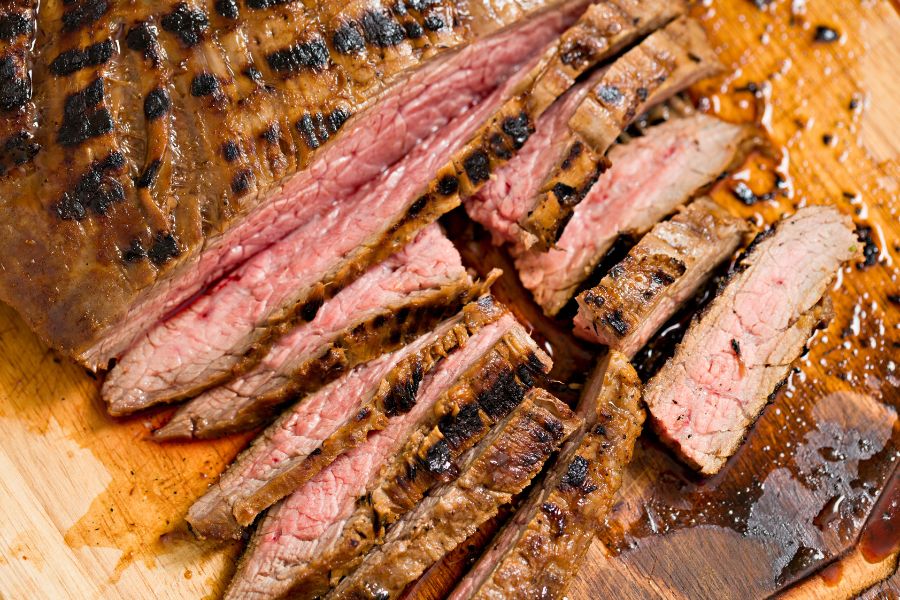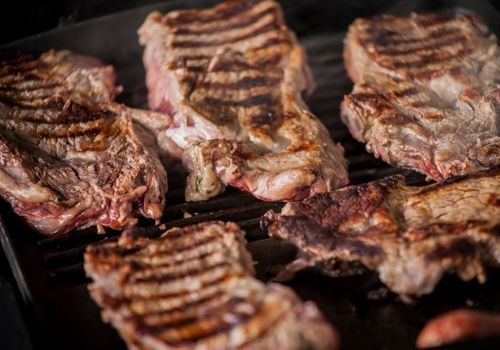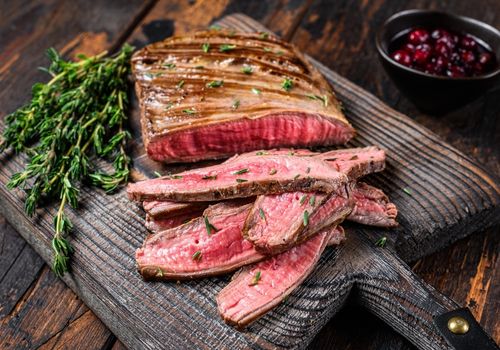The common similarity which necessitates this article is that both the flat iron steak and flank steak are really flat – talking about an inch thick – and the names are sometimes used interchangeably. So, what’s the difference? And which is the better cut, the flat iron steak or flank steak? For me, I like flat iron steaks because it’s nicely marbled, while the flank steak is leaner, chewy, and tougher. But both the two steaks are flavorful cuts of meat from different parts of the animal.
Steak fans from all over the world know what the flank steak is. But I don’t see the flat iron steaks all the time at the butcher shop or grocery stores, except for a coincidence or when you ask for the cut. But it’s a steak to try. In this article, I’ll dissect both meats, and we’ll analyze them together. This will help you to see if the flank steak or flat iron steak is worth your money and preparation time.

Below is a table that shows how the flat iron and flank steak compare:
Feature | Flat Iron Steak | Flank Steak |
Where it’s taken from | The Cow’s underside/belly | Shoulder area |
Meat texture | Extremely tender | Tough, fibrous, chewy |
Types of meat | Well-marbled meat | Lean meat |
Thickness | Around one inch | Around one inch |
Presence of bone | May be bone-in | No bone |
Taste | Very rich in flavor | Strong beefy flavor |
The flat iron steak is a fairly flat steak similar to the flank steak. However, the flank steak is leaner and tougher than the flat iron steak.
The flat iron steak, despite how “flat” it is, surprisingly has more fat marbling and has a rich flavor. The flank steak has a strong beefy flavor.
So, should you buy flat iron steak or a flank steak?
It depends on what you think is the ideal meat cut. The flank steak would be for those who like leaner and tougher steaks, and the flat iron steaks are for folks who want beef cuts with a high fat content. Both are flat and measure around an inch thick, and are best-cooked medium rare.
Although they both align with different steak eaters, I think the winner in this flat iron vs. flank steak comparison is the flat iron.
Related Reading
The flat iron steak owes its name to its shape. It’s reminiscent of an iron. This is a piece of beef shoulder similar to flank steak but more marbled.
It’s also called a top blade filet but sometimes also a flank steak.
The top blade filet, or rather, the flat iron steak, has always existed. Although it is hidden in a larger conglomerate of muscles, it is not considered in isolation and is rarely prepared. The flat iron steak has a history behind it.
The flat iron steak came following an experiment by a team of researchers from the University of Nebraska and Florida in 2001, or, say, 2002. Several reports claim both.
For decades, there was a rule of thumb in meat specialist circles. Steaks for roasting and grilling always come from areas of the cattle that are not moved much. Why?
The muscle fibers there are so tender that you can chew the meat well, even when it is raw. The flat iron steaks come from one of those areas that gets a lot of movement – the shoulder or, better still, the chuck region.
All the other muscles around the shoulder are classic cuts with a lot of connective tissue – they wouldn’t be enjoyable if fried.
It is, therefore, improbable that a section suddenly appears in this region that has completely different properties. For decades, the flat iron steak remained hidden. There was another reason for that.
A thick, flat tendon traverses the top blade steak or chuck primal area in the cow. If you cut a top blade steak or steak from the chuck, this tendon is always present.
It doesn’t get tender when grilled or fried. It stays chewy like leather or hard tissue.
That was the final KO criterion for using the flat iron as a steak. This is because it’s extremely tender than most of the steaks in the chuck primal region! It’s second to the filet mignon in tenderness.
Related Reading

There are three things to remember; on the one hand, it has an amazingly delicate texture reminiscent of a fillet. So it’s easier to cook flat iron steak.
In addition, there is higher fat marbling, which becomes more and more pronounced towards the tip.
This marbling is found even in breeds that normally have little fat. The delicate fiber and strong marbling are a stroke of luck for every steak fan.
Now comes the very best. Due to the position in the heavily moved shoulder, the flat iron steak taste is more flavorful than the fillet.
It is precisely these three facets that fuel the fascination of the flat iron steak. It’s only a matter of time before this steak catches on!
The flat iron steak is great for recipes like stir-frys and steak fajitas. Flank steaks are also used in recipes such as London broil, carne asada, fajitas, and Chinese fries.
Both the flat iron and flank steaks are quite versatile. You can apply various cooking methods. You can grill, sauté, broil, or pan-fry them.
The flank steak is a thin, lean cut of meat taken from the cow’s abdominal muscle or bottom loin of an animal. It’s fibrous and chewy like skirt steak cuts of beef. So it needs to be cooked properly but slowly.
“My favorite cut is the flank steak!” If you hear this statement, you should ask more precisely if such a person knows what meat they’re referring to.
The reason: the flank steak, like flat iron, is not a popular steak. And it’s by no means a real treat!
Most flank steaks are rather tough and hardly usable as pan-fried meat. Also, the quality of the meat doesn’t come with the steak but with your effort.
Related Reading
The flank steak comes from the belly flap of the beef. The cow’s entire body is encircled by tendons and muscles that encase the “inner workings” of the cow.
The underside of this flap, in the stomach area, has to withstand extreme forces. The bovine organs, muscles, and rumen, which is the first section of the stomach, are pulled down by gravity.
As a result, they all put their weight on the cow’s abdominal muscle. This area is exactly where the flank steak is at home.
Once you have found your dream flank steak, the hardest hurdle has been overcome – because the preparation is child’s play. The flank steak is so thin that you can grill or roast it in no time.
Start by preheating the grill or pan on medium-high heat. Rub the flank steak with coarse sea salt, and then immediately place the flank steaks on the blazing hot heat source.
Fry it on both sides, so it has strong roasting marks – about a minute on each side. Then you have to put the flank steak on an indirect heat zone on the grill or in the oven at 260 degrees and let it cook until the core is about 130 degrees.
The meat adds the last 5 degrees to the desired 135 degrees core temperature for a medium rare in the final resting phase through the circulation of the meat juices inside.
Important: A flank steak is best cooked mediumrare in medium-high heat. The core temperature of 135 degrees (medium rare) is actually necessary for the steak to create a tender mouthfeel with maximum juiciness. A rare roasted flank steak is no fun in the mouth!

The flat iron steak is a slice of extremely tender meat with rich flavor, while the flank steak has a strong beefy flavor. However, it is as tough as a plank, which is more ironic.
The shoulder blade steak is supposed to be tough, while the belly meat is tender. The reverse is the case here. The flank steak comes from the belly, where all the gravity force and weight work on the region, hence the toughness.
If you like leaner and tougher meat and know how to cook them tenderly, you’ll have no problem with that. If you like tender steaks with enough marbling, the flat iron is your steak! If you can’t find flat iron steak, a flank steak is a worthy alternative.